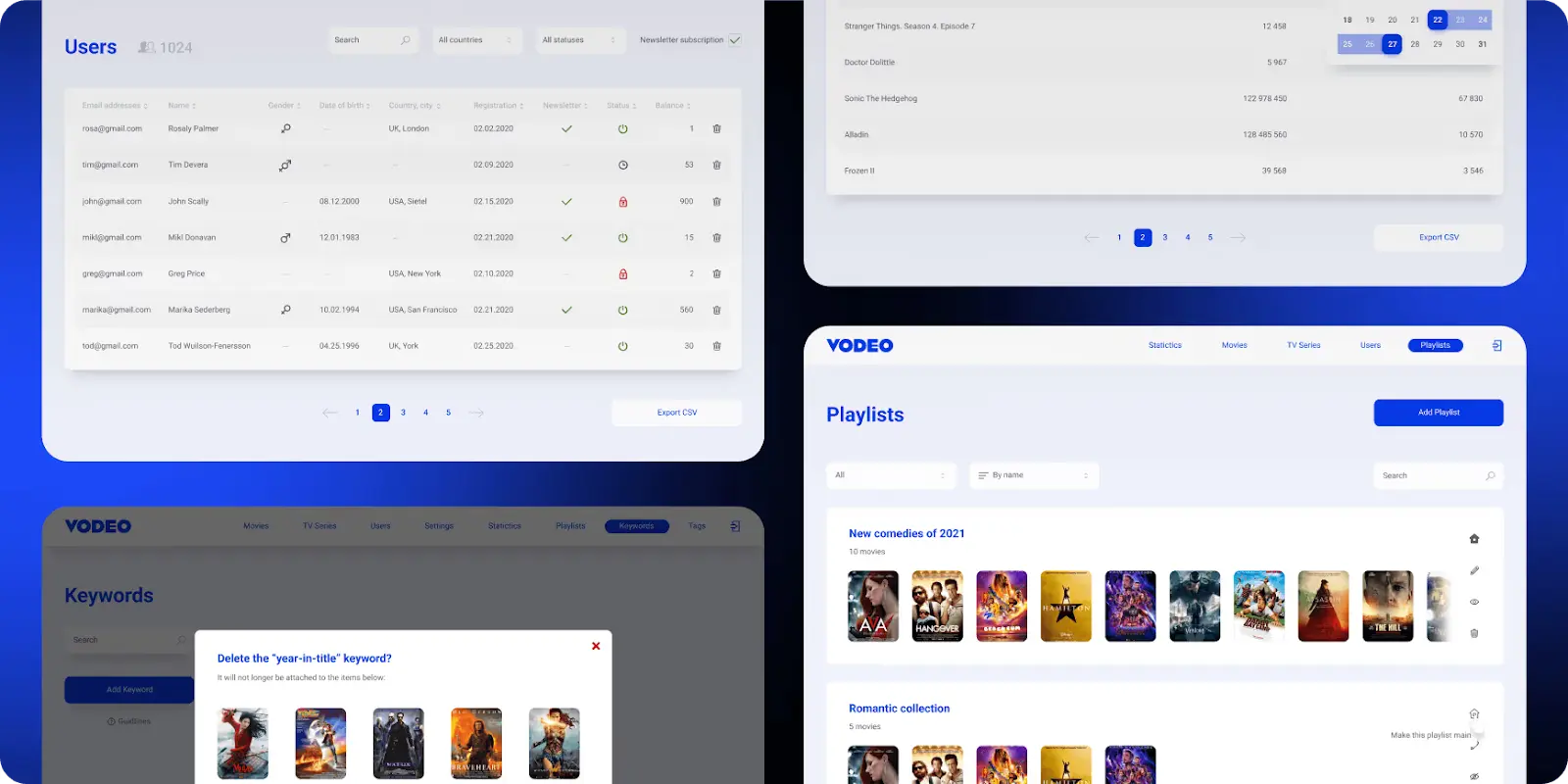
Creating an enterprise video platform for 2026 requires smart planning and careful attention to several key aspects. Modern businesses require video platforms that seamlessly integrate with their existing tools, while ensuring data security and compliance with relevant privacy regulations. When building such a platform, companies can choose between making their own custom solution or using ready-made options that can be branded.
Custom builds provide you with precisely what you want, but they require more time and money. In contrast, ready-made platforms get you started quickly, but they may limit the changes you can make. The success of your platform depends on how well you balance these choices with your budget, growth plans, and launch timeline. Good preparation and testing help make sure your platform works well for everyone who uses it. Let's examine how these various approaches can benefit your business.
Why Trust Our Enterprise Video Platform Expertise?
With over 20 years of specialized experience in multimedia development, we've been at the forefront of enterprise video platform solutions since 2005. Our team has successfully delivered numerous video streaming platforms, including projects such as Vodeo, demonstrating our in-depth understanding of the technical complexities involved in enterprise-grade video solutions. We maintain a 100% project success rating on Upwork, reflecting our commitment to delivering reliable and efficient video platforms.
Our expertise spans critical areas of video platform development, including WebRTC implementation, integration with cloud services such as Amazon S3, and custom content management systems. We've developed solutions for various industries, ranging from e-learning to Internet TV platforms, providing us with comprehensive insights into different enterprise video requirements and challenges. Our specialized focus on multimedia development means we understand the nuances of video delivery, streaming optimization, and platform scalability that general developers might miss.
Key Components of Enterprise Video Platform Development

When you start looking at enterprise video platforms, you'll see that there are key components you need. First, you must pick the right features.
Then, you need to set up the right architecture.
Essential Features and Architecture Requirements
When constructing an enterprise video platform, it is essential to consider security and compliance frameworks. These frameworks guarantee that your platform meets industry standards and protects sensitive data. In fact, 72% of respondents believe that the government should employ social media platforms to enhance communication during crises, highlighting the critical importance of secure communication channels in modern digital infrastructure (Li et al., 2023).
Moreover, your platform should integrate well with existing systems, making it easier for users to adopt and use effectively.
Security and Compliance Frameworks
As you develop an enterprise video platform, you must prioritize security and compliance frameworks. These frameworks protect data and ensure your platform development meets industry standards.
- Encryption: Use strong encryption to safeguard data. This keeps information safe as it moves between users and servers.
- Access Control: Limit who can see or change data. Only give access to those who need it.
- Compliance: Follow rules like GDPR or HIPAA. These rules help protect user data and privacy.
- Audit Trails: Keep records of who does what on your platform. This helps track and fix issues quickly.
Many companies overlook these steps. Don't be one of them. Prioritize security from the start.
Integration Capabilities with Existing Systems
To ensure your enterprise video platform is effective, it must integrate seamlessly with existing systems. Integration is not just a nice feature; it's critical. Your platform should connect with popular enterprise software. Tools like Jitterbit can help. They link different apps and data. This makes your platform more impactful.
Here's what you need to integrate:
Don't overlook these integrations. They boost your platform's value. Ensure that you test each one thoroughly.
When developing Vodeo, we ensured efficient video storage and streaming, showcasing how proper integration can enhance platform performance and user experience.
Case Study: Developing Vodeo - A Netflix-like Enterprise Video Platform

Our experience in developing Vodeo for Janson Media Group exemplifies the challenges and solutions in enterprise video platform development. We focused on creating a Netflix-like platform that would support independent filmmakers while maintaining enterprise-grade quality. The platform demonstrates how effective architecture and feature selection can lead to a seamless video streaming experience.
The project required careful consideration of several key components:
- Content Management: We developed a comprehensive admin panel for efficient content uploading and management
- Video Quality Management: Implementation of adaptive streaming (480p to 1080p) based on connection speed
- Integration with Multiple Systems: Successful integration with Amazon S3 for optimized video uploading
- Monetization Strategy: Implementation of an internal currency system for content rental
Through this development process, we learned valuable lessons about balancing user experience with backend efficiency, particularly in handling large video files through fragmented uploads to the servers.
Building vs Buying: Making the Right Choice
When choosing between building or buying an enterprise video platform, you first need to look at the costs of custom development.
Compare these costs with what white-label solutions offer.
Then, calculate the return on investment and think about long-term needs.
Custom Development Cost Analysis
Before deciding to build or buy an enterprise video platform, you must weigh the costs. A custom development cost analysis involves more than just financial considerations. You need to consider time, resources, and long-term maintenance. Quality content creation is a crucial factor, as higher-quality video content leads to significantly improved viewer engagement and interactions (Saygılı et al., 2024).
Here are key factors to examine:
- Initial Investment: Building requires a large upfront cost. Buying may seem cheaper, but it has recurring fees.
- Time to Market: Developing a platform from scratch takes time. Buying can get you started faster.
- Resource Allocation: Custom development needs a dedicated team. Buying frees up your team to focus on other tasks.
- Maintenance: Built platforms need constant updates. Bought platforms often include support and updates.
Many companies find that buying saves time and resources. However, building gives you full control and customization. Each option has its trade-offs. Analyze your needs carefully.
White-Label Solutions Comparison
The primary difference between white-label and custom-built video platforms lies in the balance between control and convenience. White-label solutions let you launch quickly and brand a pre-built platform as your own, requiring less initial effort and investment. In fact, white-label solutions can be deployed within weeks, while custom-built platforms typically require 2 to 6 months for development (Salisbury et al., 2020). However, white-label solutions come with limitations in customization and reliance on the provider for updates and fixes. Building your own platform gives you full control, allowing tailored features and greater independence, but demands more resources, time, and responsibility.
Companies like Vidyard demonstrate this path; they began with a white-label solution to enter the market quickly and later built their own platform to gain complete control over their product.
Choosing between the two shapes your platform’s flexibility, speed to market, and long-term growth.
Our experience with Vodeo demonstrates how a custom-built solution can provide unique advantages. We implemented specialized features, such as adaptive video quality and internal currency systems, that wouldn't have been possible with a white-label solution.
ROI Calculations and Long-term Considerations
After comparing white-label solutions, you'll want to consider the financial aspects. Calculating ROI for enterprise video monetization platforms involves several steps.
First, consider the initial costs. Buying a ready-made platform may seem expensive, but building one from scratch can be more costly.
- Development Costs: Building requires hiring developers and designers. This takes time and money.
- Maintenance Costs: Keeping a platform running smoothly needs constant updates and fixes. Buying may include maintenance in the price.
- Scalability: As your enterprise grows, your platform must handle more users. Buying often offers built-in scalability.
- Time to Market: Building takes longer. Buying gets your platform up and running faster.
Long-term considerations are essential. Building allows for custom features, but it demands ongoing investment.
Buying provides quick access to advanced features, although it may limit customization options. Weigh these factors carefully. Your choice will have a significant impact on your enterprise's success.
Implementation Strategy and Timeline
Before you start, list all the tools your team needs. You'll find that planning each step helps avoid surprises.
Technical Requirements and Planning
You start with the development and testing phases. These phases consume the majority of your timeline.
You spend a significant amount of time fine-tuning and testing your platform during this stage.
For instance, in our development of Vodeo, we implemented a sophisticated content management system that allows admins to upload movies in parts, significantly reducing upload times and costs.
Development and Testing Phases
When developing an enterprise video platform, the first step is to plan the development and testing phases. You'll need to outline the timeline and strategy for cross-platform development. This guarantees your platform development stays on track.
- Break down tasks: List all tasks for each phase.
- Set deadlines: Give each task a clear due date.
- Assign roles: Make sure everyone knows their job.
- Plan testing: Decide when and how to test each feature.
Regularly review and update your plan. Changes happen, so be ready to adjust.
Deployment and Maintenance Best Practices
After developing and testing your enterprise video platform, you must address deployment and maintenance. This phase involves planning and executing the rollout of your video delivery platform. You need to factor in the technical requirements and create a timeline for implementation. Using a cloud service like GCP can help manage resources efficiently.
Ensure you have a maintenance plan to handle updates and fixes. Regular checks keep the platform running smoothly. Document everything for easy reference.
Interactive Platform Planning Tool: Choose Your Development Path
Building an enterprise video platform requires making strategic decisions at every stage. Use this interactive tool to explore different development approaches, compare features, and understand which path aligns best with your business needs. Toggle between custom development and white-label solutions to see how timeline, investment, and capabilities differ for your 2026 video platform project.
Frequently Asked Questions
What Is the Cost of Developing an Enterprise Video Platform?
Developing an enterprise video platform costs between ~$12,800 and ~$50,000, depending on features such as live streaming, security, and scalability that you're including. Customization and integration with existing systems can significantly increase the cost.
How Does an Enterprise Video Platform Ensure Data Security?
You ensure data security by implementing end-to-end encryption, utilizing secure protocols such as HTTPS, and enforcing strict access controls. Regularly update your software, conduct security audits, and comply with industry standards such as GDPR and HIPAA.
Can Enterprise Video Platforms Integrate With Existing Tools?
Yes, you can integrate enterprise video platforms with existing tools, such as CRM, LMS, and CMS, using APIs or built-in integrations, thereby enhancing your current workflows without disrupting them. This guarantees a seamless experience, boosting productivity and collaboration.
What Are the Key Trends in Enterprise Video Platforms for 2026?
By 2026, you'll see increased use of AI for video analytics and personalization. Interactive videos will be mainstream, and there'll be a shift towards more 4K and 8K content. Integration with AR/VR and improved accessibility features will also be key trends you'll focus on.
How Do Enterprise Video Platforms Handle User Access and Permissions?
You manage user access and permissions through role-based access control (RBAC). Assign roles like admin, editor, or viewer, and control what each role can do. Moreover, you can set permissions for specific videos or channels, ensuring users see only what they're allowed to.
Conclusion
Developing an enterprise video platform isn't easy. You need clear goals and solid planning. Building can be costly, but it gives you control over your space. Buying saves time, yet limits customization. Weigh your options carefully. Remember, long-term success depends on smart choices now. Examine the numbers and consider the future. Your platform's success hinges on the decisions you make.
References
Li, K., Wu, X., & Tan, T. (2023). The impact of images and videos on social media platforms on surveillance. Journal of Humanities Arts and Social Science, 7(2), 408-413. https://doi.org/10.26855/jhass.2023.02.029
Salisbury, C., Quigley, A., Hex, N., & Aznar, C. (2020). Private video consultation services and the future of primary care. Journal of Medical Internet Research, 22(10), e19415. https://doi.org/10.2196/19415
Saygılı, S., Gezer, I., & Oner, H., et al. (2024). Evaluation of the reliability and accuracy of youtube™ and tiktok™ contents about storage media for avulsed teeth: A cross‐sectional study. Dental Traumatology, 40(5), 522-529. https://doi.org/10.1111/edt.12952













.avif)

Comments